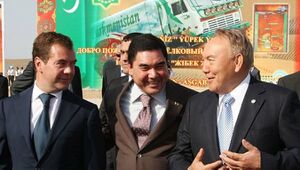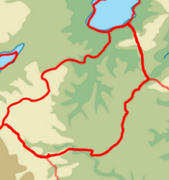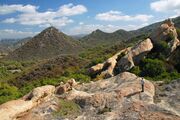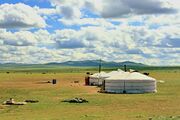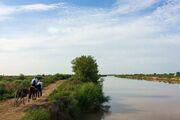Hacyinia: Difference between revisions
No edit summary |
No edit summary |
||
| Line 37: | Line 37: | ||
|official_languages = <!--Languages recognised in legislation, constitution, etc--> | |official_languages = <!--Languages recognised in legislation, constitution, etc--> | ||
|national_languages = {{wp|Persian language|Pardarian}}, {{wp|French language|Gaullican}} | |national_languages = {{wp|Persian language|Pardarian}}, {{wp|French language|Gaullican}} | ||
|regional_languages = '''Syran:''' {{wp|Tajik language|Bukhori}}, {{wp|Azerbaijani language|Kizik}}, Ziba <br> ''' | |regional_languages = '''Syran:''' {{wp|Tajik language|Bukhori}}, {{wp|Azerbaijani language|Kizik}}, Ziba <br> '''Bessharia:''' {{wp|Kazakh language|Majgar}}, {{wp|Ossetian language|Iasi}}, {{wp|Mongolian language|Ukilen}} | ||
|languages_type = Unrecognized regional languages | |languages_type = Unrecognized regional languages | ||
|languages = {{wp|Burmese language|Chanwan}} | |languages = {{wp|Burmese language|Chanwan}} | ||
Revision as of 16:33, 12 March 2022
This article is incomplete because it is pending further input from participants, or it is a work-in-progress by one author. Please comment on this article's talk page to share your input, comments and questions. Note: To contribute to this article, you may need to seek help from the author(s) of this page. |
The United Confederation of Hacyinia | |
|---|---|
|
Flag | |
 Location of Hacyinia on Kylaris | |
| Capital and | Choch |
| Recognised national languages | Pardarian, Gaullican |
| Recognised regional languages | Syran: Bukhori, Kizik, Ziba Bessharia: Majgar, Iasi, Ukilen |
Unrecognized regional languages | Chanwan |
| Ethnic groups | 44% Oroqic 31% Majgar 69% Kiziks 31% Pardarian 21% Iasi 79% Bukhori 10% Chanwan 13% Other 47% Ukilen 38% Dezevauni 15% Other (Oeguns, others) |
| Religion | 45% Irfanic 40% Badi 6% Chanwan Folk Religion 5% Solarian Catholicism 2% Zohism 2% Other |
| Demonym(s) | Hacyinians |
| Government | Devolved unitary constitutional monarchy, with the parliament operating as a de facto one party government. |
• Khan | Makbule Arda Khan |
| Erasyl Rinat | |
| Legislature | Unified Assembly |
| Establishment | |
• Orto Khanate | TBD |
• Syr Khanate | TBD |
• Khanate of Bessar established | 1790 |
• Syran independence | 1935 |
• Peoples Equalist Republic of Syran established | 1949 |
• Unification | 1994 |
| Area | |
• Total | 1,031,116.80 km2 (398,116.42 sq mi) (31st) |
| Population | |
• 2021 estimate | 36,950,235 (~ 37th) |
• Density | 35.83/km2 (92.8/sq mi) |
| GDP (PPP) | 2021 estimate |
• Total | $363.7 billion |
• Per capita | $9,831 |
| GDP (nominal) | 2021 estimate |
• Total | $80.86 billion |
• Per capita | $2,185.54 |
| Gini | 41.9 medium |
| HDI | 0.654 medium |
| Currency | Hacyinian Som (HSM) |
| Internet TLD | .ha |
Hacyinia, officially known as the Union of Hacyinia and also known as Basshar-Syran or Syran-Basshar, is a country in Coius. It borders Dezevau and Lavana to the east, Zorasan to the north and west, Shangea to the southwest, and Zomia to south. A landlocked country, it straddles the boundary between Southeast Coius and the Great Steppe physically and Greater Pardarian as well as Greater Southeast Coius culturally. The 31st largest country , Hacyinia occupies 1,031,116.80 km2. The physical landscape of the country is defined by mountainous terrain to the west, vast and sprawling steppe through much of the central area of the country, and fertile river deltas in the east along the shore of Lake Zinabad. The 37 million citizens are multi ethnic, multi lingual and multi religious, who can trace their heritage from the mosaic of nomadic and settled peoples that have influenced the countries history. Population-wise, Hacyinia is roughly the 37th most populous country in the world.
Most of Hacyinia's history has been as the vague borderlands of various larger, centralized powers nearby sans for a few gleaming city states along trade routes or recognized khanates in the steppes. The lands of Hacyinia have been conquered by various powers from near, far and homegrown. There had been little unity between the western and eastern regions of the modern country, sans occasionally being conquered by the same empire. The modern state of Hacyinia starts in the 18th and 19th century, when the Khanate of Besshar established itself in the western side of the country - an initially loose confederation of ungovernable steppe tribes and rebellious city states that secured de facto independence from a declining Aguda Empire. Besshar was recognized as an independent state and a Gaullican protectorate following the collapse of the Aguda Empire and incorporation of former Agudaian territories into the Gaullican colonial empire. Following the Great War, Syran gained independence. Unstable from the onset, beset by multiple influences in the chaotic post-war era, an Equalist coup overthrew the country establishing the Peoples Equalist Republic of Syran.
Hostilities and tension quickly arose between the two countries as they attempted to enforce their claim to the vast steppe space separating them. Border skirmishes and open conflict was common for years. It wasn't until the joint decline of both countries governments due to domestic issues that unification, brokered by international agreement, was reached and went into effect in 1994. The following 28 years has seen a dysfunctional government, partly led by former members of the Equalist Party of Syran and partly led by the Khan of Besshar, muddle through in an almost perpetual state of political crisis. The Hacyinia Troubles has only increased over the years and now it is commonly recognized by many observers, both domestic and internationally, that Hacyinia is on the brink of collapse. Besshar separatists have become more vocal and active in demanding a "two state solution", while the Syranian-led central government refuses to allow any succession to happen. Both factions with foreign backing have been more or less preparing openly for some sort of showdown that many estimate will be coming soon.
Etymology
Hacyinia comes from the Old Pardarian word "hamicyia", meaning rebellious. The descriptor of the steppe peoples eventually came to refer to the whole general steppe area south of Pardaran proper. The word didn't gain a political meaning until the mid 20th century when the first ideas of unification between Besshar and Syran were proposed. When Besshar and Syran did unify and merge into one state in 1994, the name Hacyinia was chosen as the new state name.
The names of the two competent states of Hacyinia, Besshar and Syran, are both Oroqic and Pardarian blended words. Bessharia stems from the root Besshar which means "Five Cities" and Syran translates to the "Land of Syr/Sir". Bessharia first originated from the 18th and 19th centuries when the once fairly stateless region began to centralize around the oases city states nestled into the foothills of Mount Chanwan, forming a new polity in the face of the Aguda Empires slow collapse. Gaullican map makers dubbed the land "Bessharie" during the initial exploration of Greater Southeast Coius, initially believing that Besshar was the name of a tribe rather than of the collection of cities. It was eventually !Latinzed as Bessharia during the late 19th century. Syran stems from a much earlier time, and is the result of the eponymous founder of the Syr Khanate in the 11th and 12th centuries combined with the Pardarian suffix "-an" meaning "land of". Although the Syr Khanate collapsed shortly after it's founding, the Aguda Empire adopted the local endonym of the province which then became widespread.
History
Hacyinia has a long history, dominated mostly by the nomadic peoples that have ruled from the steppes as well as powerful empires who have conquered and held sway over the area. Although the area has long been inhabited with archeological records showing evidence of human settlement dating back to 6,000 BCE; the first recorded peoples in the area date back to the second millennia B.C with !Scythian/!Saka nomads domaining the steppes and settled Pardardian speaking city states establishing themselves in the eastern river deltas by Lake Zinabad, as well as in the foothills of the western mountains. The Chanwan had long called the highlands of western Hacyinia home and began establishing their own polity's in the highlands of the Huashan mountain range. In the southwestern steppe, in the modern day borderlands between Hacyinia, Zomia and Lavana, the proto-Oroqic Ashina held sway and competed with the !Scythians/!Saka for control of the steppe. The Ashina were able to establish several of their own powerful states controlling parts of Southeast Coius until just before the end of the 1st century CE.
The almost simultaneous Badi Reaction and the expansion of the Second Heavenly Dominion
- created a bunch of chaos
- Irfanic Oroqic tribes closer to Lake Zinabad were like nah we're good, we're going to hang out with the Pasdewars instead of you Badist bums to the south
- in general some wildness. Badism survived in the SW/W of Hacyinia mostly due to the foothills/slightly mountainous terrian gave people something to defend and made invasions diffiuclt (plus gotta get through the steppe first). E Hacyinia didn't really have that, was able to be conquered and converted fairly easily.
- saw much of E Hacyinia/Syran de facto/de jure a part of the 2nd Heavenly Dominion, while W Hacyinia/Besshar was only de jure.
- start of much of the religious/ethnic spilt within the country.
Following the Tagamic Migrations
- Oroqic tribes moved in to take the places of everybody else who had migrated, further adding to the chaos of the period.
- Hacyinia was largerly unaffected? It was like the very eastern edge of the steppe and everybody seemed to be more concerned with heading up through Zorasan to Euclea.
- Start of Oroqic domniance in the steppe.
- Svai Empire ruling over Besshar during this time
The era of the Khanates
- Era of Turkic khanates and their dominance in at leas the eastern part of the steppe/around the Hushan mountain range. Maybe frequent wars with the Chanwan? Wars with neighbors for sure. Two "native khanates" with the Orto Khanate + the Syran Khanate during this time that emerged right after the other.
Aguda Empire, direct control in the east and suzerainty in the west
- Aguda Empire directly administered Syran. Utilized Clear Water Sect elites to administer country. Promoter of agriculture/irrigation/urbanization, Ziba speakers move into the area. Most of Syran has been Irfanic since the Heavenly Dominion.
- Aguda Empire attempted to also directly admin Besshar, not really able to happen outside of the urban areas. Ended up relying on just being the suzerains of the nomadic Badist Beyek, Ukilen tribes as well as the semi-nomadic Kacdags, which was an arrangement almost everybody could agree upon. Still issues with occasional tribal raids and when the suzerainty was being competed with?
- Syran came to be a core part of the Aguda Empire, and over the several hundred years of Aguda direct rule largely came to see itself as part of the wider Aguda Empire rather than "Syran." The lands of modern day Bessharia in turn began to exert more and more independence in their own affairs as the steppe tribes and city states of Besshar began to build the beginnings of a state during the decline of the Aguda Empire.
Gaullican Syran + Independent Besshar
- As Gaullica assumed direct control over the core of the Aguda Empire, also assumed control over Syran. Syran became a large cotton exporter during the colonial period, as well as vast mineral reserves exploited. Later on, oil (~35% of total Hacyinia production) was found and added to the economic value of Gaullican Syran.
- Besshar/Bessharia was in an awk. situation being surrounded by an expanding Shangea, Eturia coming down through Zorasan, and then Gaullica nearby and who knows who else. Some inital conflict broke out between Gaullica + Besshar but mostly inconclusive expeditions on both sides. Besshar agreed to protectorate status with Gaullica, giving Gaullica de jure control over the countries foreign affairs - but de facto the position was heavily competed by all nearby colonial powers ("The Smaller Game")
- Understanding the grave risk presented to them, Besshar responded by further uniting the looser tribal confederation into a more centralized state at the risk of independence. Still very decentralized, almost feudal like in a lot of ways.
- General tracks during this period - Syran turned away from Euclean influence, took cues from Dezenau and began adopting an anti-colonist mindset especially in the midst of the great war. Besshar on the other hand cautiously welcomed Euclean influence into the country, viewing it as a source of modernization/power/wealth. !Gurkhas from Besshar served in the Gaullican forces (often as a tool of colonial repression).
- Great War - Syran saw similar treatment as the rest of Gaullican holdings during the great war, probs a fair amount of conscription. Besshar stayed out of the whole thing sans being Gaullican aligned, although I can imagine that towards the tail end of the war probs did at least some sort of symbolic turn towards the victors.
Independent Syran, then Peoples Equalist Republic
- Syran was granted independence at 1935 in the peace processes following the war. Everybody had sort of shrugged and stated that they didn't really want to deal with the place and haphazardly granted it indepdence in a rushed manner.
- Initally an Euclean parliamentary style republic, very much a mess from the get go with no real structure or political development in place for the country to be independent - it had spent almost it's entire history as a part of one empire or another, and within a few months it was expected to function as an indepdent state.
- The wavering of the state led to an Equalist/Sattirst/National Princpalist inspired coup - establishing the Peoples Equalist Republic of Syran.
Conflicts/"two state period"
Decline of both states
Unification and The Troubles.
- "Inju" system attempted to be implemented, headed off by xxx, and was successful for a period.
Geography
At 1,031,116.80 km2, Hacyinia is the 15th largest in Coius, and the 31st largest in the world. It is slightly smaller than Behera and slightly larger than Belmonte. A landlocked country, it has a minimally varied terrain. The country is overwhelmingly steppe land. In the west there is the Transhuashan foothills and the plateau of the Great Steppe, while in the east there is the riparian inflowing rivers deltas to Lake Zinabad. The elevation of the country varies greatly however, with some areas being several thousand meters above sea levels and others being several hundred meters below sea levels. Generally elevation rises the in the west and closer to the Huashan mountains. The country is entirely considered to be within a Temperate grasslands, savannas, and shrublands biome, with a temperate climate. Precipitation is fairly high, and generally there is mild winters with warmer summers. The increasing desertification of nearby Zorasan has had a major impact on eastern Hacyinia in particularly, with notable land degradation impacting the agricultural output of eastern Hacyinia.
Arable land is at a minimum and mostly of the countries arable land is concreated in the east along in the river deltas and the shore of Lake Zinabad, or more limitedly in the west in mountain oases supplied by the melting glacial water of the Huashan mountains. The central steppes soil is incapable of supporting any sort of large scale agriculture, although it is more than capable of supporting large scale animal husbandry both historically and modern day. Much of the steppe has very limited water supply sans a few lakes and seasonal rivers that occasionally form. Water rights is a serious political concern, both domestically as well as internationally. Much of the water resources in the country are located in Syran and are used to support extensive commercial agriculture. The shrinking of Lake Zinabad is of great concern to the Hacyinian government, and the Syranic government before that.
Wildlife
Bactarian deer! Bactarian camels! Wolves! There's brown bears in Central Asia apparently? Snow leopards, cut & paste from stuff. Horses!
Demographics
Population is actually suprinsingly dense and kinda urbanized? Since most of the population is on either the far western or the far eastern sides of the country, just a bunch of open space in the middle. Solid chunk of the population still practice nomadism.
Population of Bessharia: 14,041,089.30 or 38% of Hacyinia Population of Syran: 22,909,145.70 or 62% of Syran
religion - fairly evenly divided between Badist and Irfanic worshippers if you look at the mass of population together. Bessharia is majority Badist, with minorities of Chanwan Folk Religion/Zohism/Irfan. Syran is majority Irfanic, small minority of Badists (Clear Water Sect) + Solarian Catholicism. Religious relations between the two largest sects is mixed at best, discrimination is common and more so common for members of a religious minority. generally teligious minorities get the hint to oractice in a lowkey manner. irreligon, even in Syran, is odd and Equalist Syran actively attempted to cultivate a "Irfanic Equalism" for a bit
ethnic groups - Oroqic and Paradarian ethnicties make up the largest 2 in the country, with Chanwan and Others making up sizeable minorities. however, sharp divisions between different "sub" ethnic groups exisit. Beyeks and Ilkmen seperated by a language difference, further seperated for historical/religious/cultural reasons. Kacdags and Pasdewars are similarly seperated. Generally, Besshsria has a larger prescene of "other" minorities such as Ukilen, Oegun. Syran is more dominated by Ilkmen, Pasdewars with a sig minority of Dezenanu folks. The Chanwan primarily live in the higher elevations of the Hushan mountains, and generally are ignored at best and perscecuted at worst. very much told to stay in their tradtional homeland, smaller populations of "urban" chanwan exist with notably poor social health outcomes.
languages - as a multilingual, multicultural country there is a distincit need for "linga francas" for everybody to communcatie. Pardarian historically filled that role, since colonization/contact with Euclea, Gaullica has also rose to fill that role. currently both are utilized pretty frequently, albeit with all things in the country many things are divided. Bessharia had adopted Gaullican language education since early contacts with them, while Syran typically utilizes Pardarian due to the large Irfanic population of the country already fluent in it.
Urbanization
cities: Bessharia: Maymana Tuska* Sarai Tulean Yutti (Most of population in Bessharia is at the capital. Bessharia is very much "yup, cities have a fair amount of the population - and then outside of the city theres not really...anything? Like it's just nomadic steppe beyond that. Like I imagine just clusters of really dense living, and then just nomadic steppe outside of that)
Syran: Choch ** Halac Satlyk Shirvan Babak (As a river delta civilization, much more extensive amount of cities/towns living in the river delta. I think similar to Bessharia in that outside of places that is a settled/town development then empty steppe, albeit the "empty steppe" part is not really there as much as it is in Bessharia.)
Government and Politics
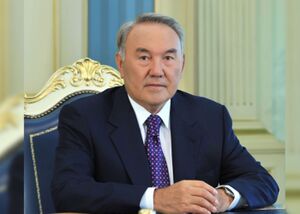
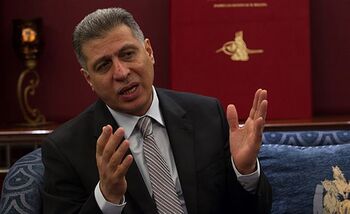
Following the 1994 Unification of Hacyinia, the central government of Hacyinia was formed as a merger between the weakened absolute monarchy of Bessharia and the collapsing one party Equalist regime of Syran. The creation of the government was guided by the concept of the "Inju System" created by Makbule Arda Khan of Bessharia and Rahym Gul, the first Prime Minister of Hacyinia and recent former Premier of Syran. The "Inju System" called for the establishment of a "dual power" system with the Khan of Bessharia functioning as the new governments Head of State and a Prime Minister, who by law has to be from Syran, elected from the unicameral Unified Assembly parliament to function as Head of Government. The Inju System envisioned Hacyinia as a devolved unitary state, with the intention that the Head of State and the Head of Government would function as corulers over a large central state, while allowing the now subnational states of Bessharia and Syran to legislate and rule according to how they see fit. The decision of a unitary or a federal state was negotiated extensively between Makbule Arda Khan, who advocated for a confederation or federal state, and Rahym Gul, who advocated for a strong and centralized state. Ultimately the comprise of a devolved unitary state was reached primarily at Rahym Gul's insistence, believing that "a united state in which one of the partners can suddenly divorce the other will ultimately weaken both, we must either join together and keep together or we will wither and rot separately." In addition to governing over the entire country together, each of the corulers was tasked with ensuring that the elites of Bessharia and Syran collaborated with and functioned for the central state in a consocialtionalist model. Citing enormous differences in each of the compotent states cultures, as well as population centers, it was agreed that utilizing the elites of both states would be most effective and was planned to be a temporary "stop-gap" as the central Hacyinian state expanded.
Initially, the Inju System worked well and was praised internationally for bringing peace to a troubled area of the world. It was considered a "uniquely Hacyinian solution to uniquely Hacyinian problems." Although far from perfect, as evidenced by early instability in both Bessharia and Syran over new laws and regulations that couldn't be uniformly applied to both states, the Inju system was promising. Spearheaded by Makbule Arda Khan and Rahym Gul, who got along famously well, it was expected that a new era of united Hacyinian history was due to begin. However, in 2001, Rahym Gul was diagnosed with cancer later passing away in 2003. It's generally understood that this is when the breakdown of the Inju System began, as a string of Prime Ministers were elected from the "old Equalist guard" and conflicted heavily with the Khan. The Khan himself, partly due to frustration with the various Prime Ministers, began to be less and less engaged in maintaining the Inju System - allowing the elites of Bessharia to express their discontent and eventually their desires for independence. The central Hacyinian government in turn responded by bringing more and more Syranic elites - almost exclusively drawn from the former Syranic Equalist Party ranks - into positions of power in the government and forcing Bessharian elites out. The delicate balance that was once maintained in the government became disjointed and has led to much of the current dysfunction in the Hacyinian government. Most observers agree that at this point that Hacyinia is rapidly collapsing in on itself, with the general consenous being that "if Hacyinia survives until it's 30th birthday, then it would be a miracle."
Political Culture
Hacyinia has a long history of authoritarian rule in both Bessharia and Syran. Until 1994, Bessharia was ruled as an absolute monarchy while Syran was a one party dictatorship who claimed legitimacy through sham and uncontested elections. During the unification process, it was not planned for the masses of the country to meaningfully participate in unification or in the political systems following. Since the establishment of the Unified Assembly in 1998, the political culture in Hacyinia has begun to shift slightly. The Khan of Bessharia established the first official opposition party "The Blue Party" in order to contest elections against the "Peoples Party" in the unicameral parliament. Although the Blue Party exists little more than to support the Khan in the government, Hacyinia has had their first contested elections in it's entire history. It's given citizens the first official outlet to express their opinions and views, albeit in a carefully moderated setting.
Most political culture, both before and after unification, was instead expressed through elites in Bessharia and Syran. The central government actively utilized and encouraged a consociationalist model in an attempt to facilitate stability in the new state. In Syran a wide variety of officials in institutions such as trade unions, the Peoples Party, the intelligentsia, etc. were utilized to ensure loyalty to the new state. In Bessharia tribal/clan leaders from the Majgars, Iasians and Ukilens as well as Badist leaders were used to the same effect. Since 2003, the Khan of Bessharia has given de facto permission to Bessharian elites to openly discuss their dissatisfaction of the Hacyinian union and protected them from retaliation from the central government. In Syran the political elites almost overwhelmingly support the union, viewing it as an extension of Syran.
Mass political culture is dependent on the component state. In Syran, most citizens view the Syranic and Hacyinian government as one in the same and generally state their loyalty to Hacyinia. Most in Syran believe that the Hacyinian troubles can be blamed for "Bessharians not believing in the system/process" and that "Bessharians are a backward people" per public opinion surveys completed in 2020. In Bessharia, there is high distrust of the central government. The Khan is a highly popular figure in Bessharia and the office is viewed as a symbol of the nation. In a public opinion survey in 2020, most Bessharians believe that "The central government doesn't understand us" as well as "Syranics are domineering and want to control everything." Several criticisms have been launched against this series of public opinion surveys, primarily that the public opinion surveys captured only opinions of the abovementioned political elites. Some have suggested that the mass of people in Hacyinia have low trust and engagement with any political authority, and any loyalty expressed only reflects necessity or fear of retaliation.
Parapolitics
Paramilitary organizations and politics in Hacyinia are deeply connected. Parapolitics has the deepest roots in Bessharia where the Khan of Bessharia has traditionally been the patron and host of the Ulans ("lancer"), which are primarily nomadic tribes and clans located in the steppe regions of Bessharia, particularly around the border of Lavana, Zomia, and Syran. The Ulans originated during the Terjasa Conflict as nomads from Bessharia flocked to join the January Uprising. The Khan of Bessharia notably funded and protected the Ulans, equipping and funding them to international discord. Since Unification, the Khan has officially relinquished his patronage of the Ulans albeit many note that his patronage is merely routed through backchannels. The Ulans are the military wing of the broader Bessharian independence movement, and are responsible for a wide variety of attacks, kidnappings and assassinations related to the movement.
Largely in response to the Ulans and a inability for the Hacyinian central state to respond, Pro-Unionist paramilitaries began to form with backing from the Hacyinian security forces. The "Agbashs" ("White Heads") are responsible for retaliatory attacks against the Ulans, assassinations against Anti-Unionists within Syran, retaliatory attacks against the Majgar minority within Syran, as well as other duties. Hacyinian security forces are known to protect and fund the Agbashs, and connections between the Agbashs and Hacyinian intelligence services run deep.
Human Rights
Hacyinia is alternatively considered a hybrid or a authoritarian regime. Hacyinia, as well as it's competent states prior to unification, has a long history of poor human rights. Generally civil and political liberties such as the freedom of assembly, freedom of speech, and others are either limited at best or nonexistent at worst. Although legally there is some protections for citizens rights; torture, arbitrary arrest, and killings by state forces are common responses to those attempting to exercise those rights. Political freedoms are highly limited as well. There is contested elections between the Peoples Party and the Blue Party, and interestingly there is some de facto freedom of speech, press and assembly within the subnational component states in decrying the opposition. In Bessharia it's common to see Anti-Union protests and print media in the urban centers, while in Syran it's equally common to see the same in support for the Union. However holding the opposite view such as Pro-Unionism in Bessharia or Anti-Unionism in Syran is typically met with harsh punishment. Some international observers have labeled this as "managed free speech" or "free speech within the box" in order to describe the phenomena.
Political parties
Largest is the "People's Party" - largely comprised of ex-Equalists from the PERS as the "old guard" of the party, with a younger cohort of folks (largerly influenced/socialist schooled in Dezenau). Domiant party in Hacyinia politics, has a vaugely leftish platform and at least with the old guard fairly auth. Historically PERS was inspired by National Princpialism, Sattarism and Equalism and old guard keeps those inspirations. Smaller parties include the "Unionist Party", platform is primarily advocating for Bessharia/Syran to remain as a united state with democratic party; the "Blue Party" which supports the Khan of Bessharia, 'Bessharia rights/nationalism' which largerly translates into indepdence; the "National Alliance" which is similar to the Unionist Party albeit has more of an auth lean; finally the "Reformed Equalist Party" which is neo-equalist party, looks to Shangea for alot of influence. Generally Peoples Party wins majority of votes (~60% of total vote), second largest is the Blue Party (~20% of total votes), other three parties spilt last 20% of the vote between themselves in a variety of ways.
Foreign Relations
Syran had a lot of relations with the socialist bloc/equalist bloc. As Equalism as seen as more and more astray, Syran became increasingly isolated from the greater socialist world leading to the unification. Even today - Syranian leaders wish to align themselves more with Dez/Lav. Bessharia was a bit isolationist - had a lot of relations with Royalist Lav/Shah of Pardaran before their fall. Close with Zomia even now, developed closer relationships with Zorasan if only because of a mutual distrust of Dez. Gaullica is a sticking point - Bessharia likes Gaullica, Syran dislikes Gaullica. Bessharia distrusts Shangea, cultivates relationships with Senria in order to not be so reliant on immediate neighbors. Syran likely respects Shangea, also likely is a one way street. Syran is very practical - only really concerns relationships with immediate neighbors + socialist bloc. Bessharia had cultivated relationships with a wide variety of folks, "third neighbor policy" + small gastrodiplomacy initative
Military
Maybe at one point kinda solid? But now largely the central military is just existing on paper, much of the military is more or less more loyal to either Besshar/Syran then they are to the entire state. Paramilitary orgs, unofficially offically backed by each side, has become the norm as each side prepares for a reality where there may be a civil war/war for indepdence if stuff cant get figured out. Went through a tough time post unification of merging two different militaries with a hx of conflict between the two, and despite coming from two militaries (Royal Bessharia Armed Forces + Peoples Equalist Republic of Syran Peoples Guards) who were semi competent on own terms (not like superpowers but enough for them to defend themselves) Both sides/Hacyinia central military is well known for having access to a small stockpile of chemical weapons which concerns international obvs for any potentional outbreak of violence. Largescale de-professionalization of the military happened post unification, with the "professional soldier class" largerly resigning/ending tours of service and many finding work in PMCs abroad.
Economy
think Mongolia/Kazakhstan/similar stuff. Oil producing = 1,229,357 barrels per day? I think a big thing with the economy is that is actually could be really powerful, but, with the domestic shitshow going on its unlikely to reach anything close to it's potential in any due time. PetroLav has a pretty solid foothold in at least Syran. Talks within Besshar of building an oil pipeline through Zomia to Nav/Kuth to reduce dependence on immediate neighbors.
Bessharia = holds roughly 65%-70% of oil and mineral resources in the country. Limited agricultural (sans animal/pastoral products) and industrial activity in the country, as well as limited financial services and others. ~ 1/3 of the country lives below the poverty level. Very petrostate, very pasture.
Syran = Much more developed, varied economy. Has 30-35% of all oil/mineral resources in the country (originally assumed to be most if not all of it up until really the 1950s/60s(??). Much more extensive agricultural (cotton), industrial and financial services. Generally to be considered the more "developed" out of the two states. Key areas of industry is cement/construction materials production, textiles, light industry/food production.
With the .ha internet code, had actually made some money selling it to Estermish speaking comedy websites. Bit of a poltical issue within the country, as some feel like it is disrespectful while others don't really care.
Culture
Culturally Besshar is more turko-mongol (Kazakh/Mongol), Syran is more turko-persian (Tajik/Uzbek). Heavy influence from SE Asia for both Syran + Bessharia, I imagine national food sorta similar to the Uyghurs/Hazaras? You know we be making rugs. Besshar is Badist, Syran is Irfanic. some Euclean influence penetrated Besshar/Syran.
- Architecture and arts: Those chechen towers common in Bessharia, Syran is known for cities like !Bukhara and !Samarkand which is filled with beautiful Pardarian style buildings and architecture. - Clothing: folk clothing: Deels for Bessharia. Clothing style for Syran I feel like would be more Persianized, (Iranian/Uzbek/Tajik traditional clothing). Traditional caps pretty common for both countries, with Telpeks common in Syran + Papakha in Bessharia - the Doppa/Tubeteika/bakol kinda common throughout. I think we would see a mix of traditional/"modern" clothing, with Syran being more "modern" and Bessharia being a bit more "traditional."
Sport
Rugby union is most popular team sport. og known as tülkhekh (mongolian)/sxojyn (oss)/ïterw (kaz) ["to push"]; Eucleans were like "damn I know a game like that" and introduced rugby to folks proper. Much more popular in the west, used as a piece of cultural/'civilizing' imperialism. "rugby diplomacy" was/is a strategy used by Besshar and to a much less extent Hacyinia in order to build diplomatic relationships with primarily Euclean and other countries to avoid being so overly dependent on the neighbors. Syran following the equalist revolution was like "nah we dont rugby anymore because it's bourgeoius af" and was more of the gymnastic socialist. Maybe their more into soccer?
Kokpar also very popular, as well as other equestrian games/activities owing to countries steppe and horse culture. Mongolian wrestling/Turkic wrestling also popular. Something like Naadam very possible. Olympic weightlifting also very successful and popular sport between two countries.

